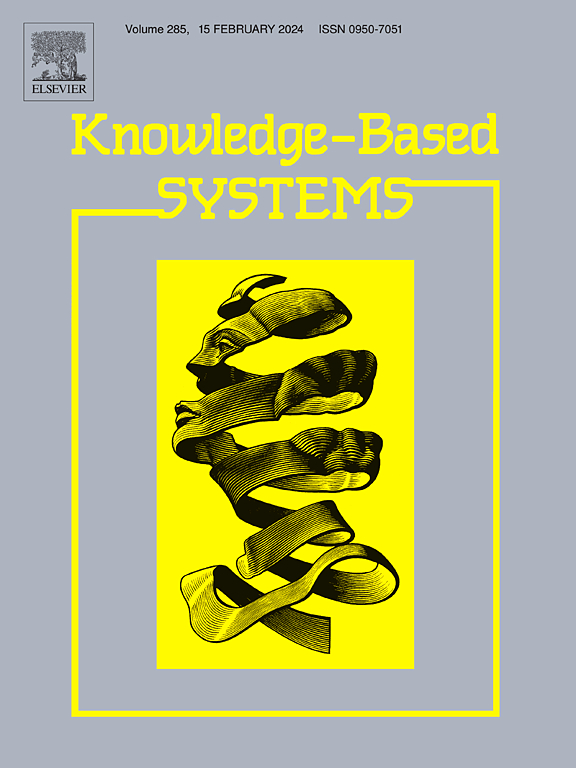TGPO-WRHNN: Two-stage Grad-CAM-guided PMRS Optimization and weighted-residual hypergraph neural network for pneumonia detection
IF 7.2
1区 计算机科学
Q1 COMPUTER SCIENCE, ARTIFICIAL INTELLIGENCE
引用次数: 0
Abstract
Recent studies based on chest X-ray images have shown that pneumonia can be effectively detected using deep convolutional neural network methods. However, these methods tend to introduce additional noise and extract only local feature information, making it difficult to express the relationship between data objects. This study proposes a Two-stage Grad-CAM-guided pre-trained model and removal scheme (PMRS) Optimization and weighted-residual hypergraph neural network model (TGPO-WRHNN). First, our model extracts high-dimensional features using the TGPO module to capture both global and local information from an image. Second, we propose a new distance-based hypergraph construction method (DBHC) to amplify the difference between distances and better distinguish the relation between nearby and distant neighbors. Finally, we introduce a weighted-residual hypergraph convolution module (WRHC) to ensure the model maintains excellent performance, even at deeper levels. Our model was tested on a dataset of chest X-ray images of pediatric patients aged 1 to 5 years at the Guangzhou Women and Children’s Medical Centre by 10-fold cross-validation. The results showed that the method achieved a maximum accuracy of 98.97%, precision of 98.86%, recall of 98.43%, F1 score of 98.64%, and AUC of 99.78%. Compared to other existing models, our model demonstrated improvements of 0.87%, 0.86%, 0.16%, and 0.38% in terms of accuracy, precision, F1 score, and AUC, respectively.
TGPO-WRHNN:两阶段 Grad-CAM 引导的 PMRS 优化和加权残差超图神经网络用于肺炎检测
最近基于胸部 X 光图像的研究表明,使用深度卷积神经网络方法可以有效检测肺炎。然而,这些方法往往会引入额外的噪声,并且只能提取局部特征信息,难以表达数据对象之间的关系。本研究提出了两阶段 Grad-CAM 引导的预训练模型和去除方案(PMRS)优化和加权残差超图神经网络模型(TGPO-WRHNN)。首先,我们的模型使用 TGPO 模块提取高维特征,以捕捉图像中的全局和局部信息。其次,我们提出了一种新的基于距离的超图构建方法(DBHC),以放大距离之间的差异,更好地区分近邻和远邻之间的关系。最后,我们引入了加权残差超图卷积模块(WRHC),以确保模型即使在更深的层次上也能保持出色的性能。我们的模型在广州市妇女儿童医疗中心的 1-5 岁儿科患者胸部 X 光图像数据集上进行了 10 倍交叉验证测试。结果表明,该方法的最高准确率为 98.97%,精确率为 98.86%,召回率为 98.43%,F1 分数为 98.64%,AUC 为 99.78%。与其他现有模型相比,我们的模型在准确率、精确度、F1 分数和 AUC 方面分别提高了 0.87%、0.86%、0.16% 和 0.38%。
本文章由计算机程序翻译,如有差异,请以英文原文为准。
求助全文
约1分钟内获得全文
求助全文
来源期刊

Knowledge-Based Systems
工程技术-计算机:人工智能
CiteScore
14.80
自引率
12.50%
发文量
1245
审稿时长
7.8 months
期刊介绍:
Knowledge-Based Systems, an international and interdisciplinary journal in artificial intelligence, publishes original, innovative, and creative research results in the field. It focuses on knowledge-based and other artificial intelligence techniques-based systems. The journal aims to support human prediction and decision-making through data science and computation techniques, provide a balanced coverage of theory and practical study, and encourage the development and implementation of knowledge-based intelligence models, methods, systems, and software tools. Applications in business, government, education, engineering, and healthcare are emphasized.
 求助内容:
求助内容: 应助结果提醒方式:
应助结果提醒方式:


